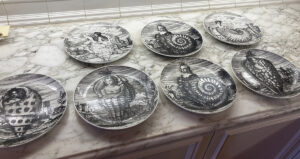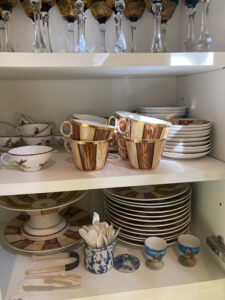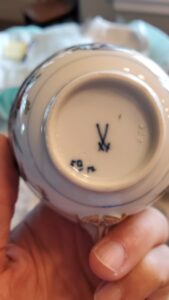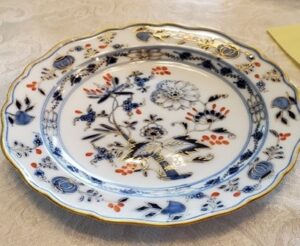What should I do with my fine porcelain dinnerware? I hear this question weekly. The market for ceramics softened across the board due in part to the lack of young buyers. Think of those matched china sets and service pieces we Boomers and Gen Xers requested on our wedding registries. Only the rarest traditional porcelain services by the top end makers sell today. Saleable services include the surrealist designs of Fornesetti or the Smithsonian-worthy designs of Russell Wright.
 If porcelain intrigues you in spite of the climate of the market, and you enjoy a matched service on a nicely set table, read Edmund de Waal’s 2015 book, The White Road: Journey into an Obsession. His story tells of the discovery of the chemistry of porcelain in China one thousand years ago, and the discovery of porcelain’s ingredients in Europe a mere 300 years ago. The quest for how to make porcelain in Europe is filled with treachery and desire. Kings and noblemen spent enormous sums to export porcelain from Asia. Princes put large cash rewards forward to any scientist who found the elements needed to make porcelain in Europe.
If porcelain intrigues you in spite of the climate of the market, and you enjoy a matched service on a nicely set table, read Edmund de Waal’s 2015 book, The White Road: Journey into an Obsession. His story tells of the discovery of the chemistry of porcelain in China one thousand years ago, and the discovery of porcelain’s ingredients in Europe a mere 300 years ago. The quest for how to make porcelain in Europe is filled with treachery and desire. Kings and noblemen spent enormous sums to export porcelain from Asia. Princes put large cash rewards forward to any scientist who found the elements needed to make porcelain in Europe.
According to de Waal, when he speaks about the lust for porcelain in the 18th century, he comments: “This level of materialism, after all, is never about necessity. There are the pleasures of being envied and the pleasures of being feared and the pleasures of looking down on a sea of new possessions, but of all the pleasures,” he writes, “MORE is the only thing that works.”
Two Factors Influence Today’s Disdain for Fine China
 In general, we don’t give those elaborate dinner parties anymore. Second, setting a fine table and taking care of crystal, silver and fine china takes time!! None of us have that luxury. As far as acquisitions are concerned, many folks want to spend their money for experiences, not objects. Many of us forge new ways of being ‘in family.’ We see a shift away from generational family life and the passing down of symbols of those generations. Surprisingly, children grow up not owning many real, physical things. Kids partake of movies on Netflix, books on Kindle, music in the ether, games online. Having a collection of objects is perhaps a thing of the past.
In general, we don’t give those elaborate dinner parties anymore. Second, setting a fine table and taking care of crystal, silver and fine china takes time!! None of us have that luxury. As far as acquisitions are concerned, many folks want to spend their money for experiences, not objects. Many of us forge new ways of being ‘in family.’ We see a shift away from generational family life and the passing down of symbols of those generations. Surprisingly, children grow up not owning many real, physical things. Kids partake of movies on Netflix, books on Kindle, music in the ether, games online. Having a collection of objects is perhaps a thing of the past.
In a client’s attic recently I came across a collection of vintage US coins in those little cardboard blue books with circular slots. Remember those? I wondered what my grandkids might store in boxes in their attics in 2084.
A Social Side to Collecting
Furthermore, clubs and societies around certain objects are fast fading—think of the stamp collector’s clubs or the quilter’s clubs of the past. My friend formerly collected Wedgwood and attended the Wedgwood International Seminars, an annual worldwide conference in early May; this year in Pasadena. Wedgwood’s founder was the second European potter to discover how to make and fire porcelain. Three-hundred people used to attend these seminars in the 1960s. Today they’re lucky to reach a hundred, with few young faces. The market for Wedgwood is the auction market where Wedgwood services sell for $500 and under.
So what brand of Dinnerware will sell?
Meissen, the birthplace of European porcelain, where potters discovered porcelain’s chemistry, became the early 18th century house known for top quality. Today Meissen is one of the few fancy porcelain brands that sell.
 My client owns a service for twenty-four place settings. Each place setting contains approximately five pieces, plus the service includes tea and coffee pots, platters, bowls, and gravy boats. This matched, polychromed (many colors: specifically blue and red on pure white slip), and gilded set (accented with 24K gold) is called Meissen Blue and Red Onion. Note the onion shape design around the rim of the plates. A nice heft indicates authenticity, as Meissen made dinnerware to last. Turn over a piece and you see the blue crossed swords emblematic of Meissen, although competitors often copied the mark.
My client owns a service for twenty-four place settings. Each place setting contains approximately five pieces, plus the service includes tea and coffee pots, platters, bowls, and gravy boats. This matched, polychromed (many colors: specifically blue and red on pure white slip), and gilded set (accented with 24K gold) is called Meissen Blue and Red Onion. Note the onion shape design around the rim of the plates. A nice heft indicates authenticity, as Meissen made dinnerware to last. Turn over a piece and you see the blue crossed swords emblematic of Meissen, although competitors often copied the mark.
Bonhams Skinner sold a set like this in one color, blue, called Blue Onion, with a lesser piece count for $10,455. I consider that auction house a good choice for Meissen sales, and predict my client’s set would bring slightly more than $10,000 for the set. The main problem: it needs packing and shipping!
European Porcelain
 For most of human history tableware was either wood or some type of metal, or something ‘found’ like shells and gourds. Not until Louis XIV in the 17th century did matched sets of dinnerware exist. He came up with idea of having a formal table service. The Sun King’s court at Versailles boasted dinner tables with sets of royal porcelain decorated with emblems of Louis XIV’s lavish courtly lifestyle and cyphers of his reign. His court set the standard for French porcelain, popularizing it across Europe.
For most of human history tableware was either wood or some type of metal, or something ‘found’ like shells and gourds. Not until Louis XIV in the 17th century did matched sets of dinnerware exist. He came up with idea of having a formal table service. The Sun King’s court at Versailles boasted dinner tables with sets of royal porcelain decorated with emblems of Louis XIV’s lavish courtly lifestyle and cyphers of his reign. His court set the standard for French porcelain, popularizing it across Europe.
England set the other standard for porcelain made for foodstuffs in the 16th century with porcelain made for the taking of tea. The tea service ‘a la russe’ called for tableware worthy of the event of high tea, including small plates for delicacies. Early English ceramicists (potters) fashioned matched sets based on silversmithing designs for teapots and creamers. The teacup originally had no handle, and hot tea was poured from the cup into the saucer to cool; tea was taken from the saucer. In the 17th and 18th centuries the wealthy in England and Holland ordered porcelain dinnerware sets designed with family cyphers from China, brought from Canton by the great Dutch trading companies. Just one piece of these sets cost more than average man made in one year. But today you can’t give your Lenox or Noritake away.